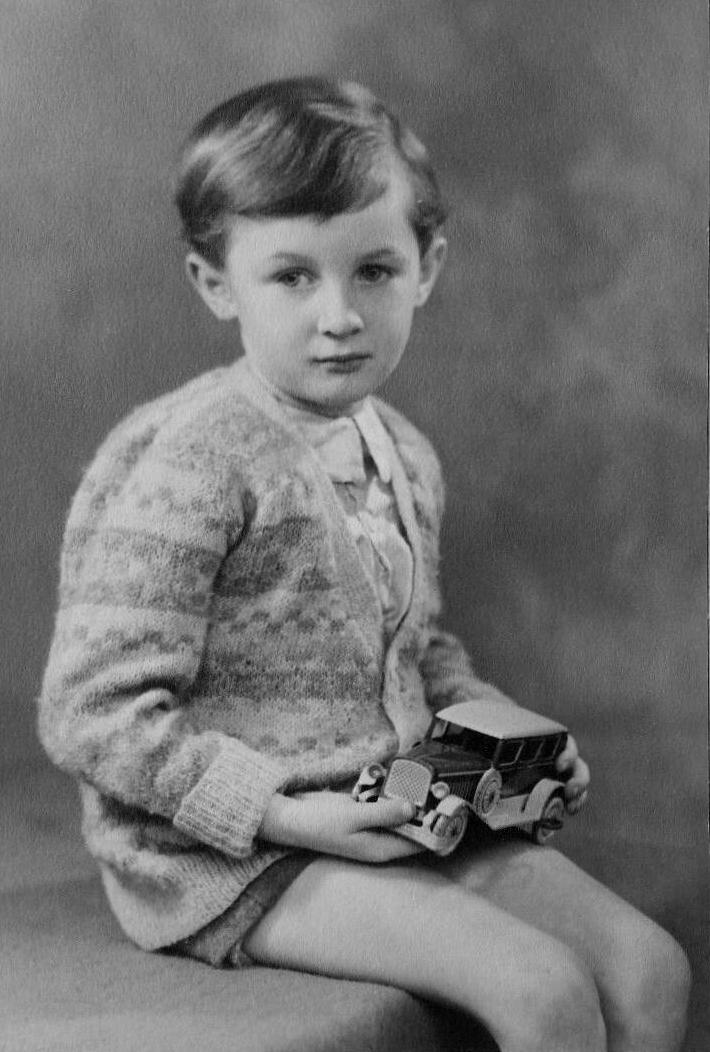
Figure 1.--This unidentified English boy wears a patterned cardigan sweater. Notice the large collar of his blouse. The boy looks to be about 4 years old. The portrait is undated, but going with his toy car, we would guess the 1930s. |

|
The most common English knitted outer-wear garment as in most countries were sweaters, especially the countries with cold weather. England does not have especially cold winters, but the variable weather even during the day makes the sweater a very useful garment. We are not sure, however, how common sweaters were in the 19th century. They are not prominent in the photographic record, but that may be because mothers used to dress boys up in their best outfits for formal portraits. We do indeed see more images of boys wearing sweaters with the advent of amateur family photography and the snapshot after the turn-of-the 20th century. We note, for example, one unidentified boy photographed about 1905. Sweaters for young boys might have buttons at the shoulders to make it easier to help them dress and undress. After World War I (1914-18) their are countless images of English boys wearing sweaters. Some English boys during the 1920s began wearing sweaters, which tended to to be made longer than now, over their pants--usually short pants. There were even knitted pants for younger people. They were often done as matching items for knitted tops. This fashion was, however, not as pronounced as on the Continent. We have observed this same convention in other countries--including Belgium, France, Germany, and the Netherlands. We do not know why this convention developed. Later the sweaters became shorter and were cut at the waist and even tucked inside the pants. The sweater was an important school garment, often dome in grey. Sweaters were usually solid colors until after World War II. We also note a variety of knitted suit outfits, meaning sweaters and matching pants. These outfits made for boys were mostly short pants outfits. After World War II we note some long pants snow suits. There were also a variety of other knits like mittens and scarves.
A sweater is a knitted garment typically with long sleeves, worn over the upper body and garments like blouses and shirts. Sweater is the generic American term. It is understood in Britain, but more often terms like
pullover, jumper, or jersey are used. The terms have different meanings in American English. In America 'jumper' refers to a style of girl's sleeveless dress, worn over a blouse or shirt, and 'jersey' refers to a knit shirt, especially if part of an sports uniform. The most common English knitted outer-wear garment as in most countries were sweaters, especially the countries with cold weather. England does not have especially cold winters, but the variable weather even during the day makes the sweater a very useful garment. We are not sure, however, how common sweaters were in the 19th century. They are not prominent in the photographic record, but that may be because mothers used to dress boys up in their best outfits for formal portraits. We do indeed see more images of boys wearing sweaters with the advent of amateur family photography and the snapshot after the turn-of-the 20th century. We note, for example, one unidentified boy photographed about 1905. Sweaters for young boys might have buttons at the shoulders to make it easier to help them dress and undress. After World War I (1914-18) their are countless images of English boys wearing sweaters. Some English boys during the 1920s began wearing sweaters, which tended to to be made longer than now, over their pants--usually short pants. Later the sweaters became shorter and were cut at the waist and even tucked inside the pants. The sweater was an important school garment, often dome in grey. Sweaters were usually solid colors until after World War II.
We also see knitted tops for younger boys look like sweaters, but they were often worn without blouses or shirts, so they can not be classified as sweaters. They were commonly worn with knitted pants by younger boys. We also see knitted garment worn as tops by older boys. They may look like sweaters, but the basic difference is that sweaters generally do not have collars, the major exception is the rolled collar. There were a variety of collars. Rughby collars were popular. We are not sure about the chronology, but believe this was the case in the mid-20th century. Knitted tops were worn without blouses or shirts underneath.
There were even knitted pants for younger people. They were often done as matching items for knitted tops. This fashion was, however, not as pronounced as on the Continent. We have observed this same convention in other countries--including Belgium, France, Germany, and the Netherlands. We do not know why this convention developed.
We also note a variety of knitted suit outfits, meaning sweaters and matching pants. This was a style for younger boys. These outfits made for boys were mostly short pants outfits. After World War II we note some long pants snow suits. There were also a variety of other knits like mittens and scarves.
Navigate related Boys' Historical Clothing Web Site cold weather pages pages:
[Return to the Main English knit page]
[Return to the Main English garment page]
[Coats]
[Knits]
[Leggings]
[Sweaters]
[Underwear]
[Other cold-weather wear]
Navigate the Boys' Historical Clothing Web Site:
[About Us]
[Introduction]
[Activities]
[Biographies]
[Chronology]
[Clothing styles]
[Countries]
[Topics]
[Bibliographies]
[Contributions]
[FAQs]
[Glossaries]
[Images]
[Links]
[Registration]
[Tools]
[Boys' Clothing Home]
